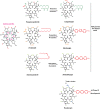Insight into advances for the biosynthetic progress of fermented echinocandins of antifungals
- PMID: 37885073
- PMCID: PMC10832530
- DOI: 10.1111/1751-7915.14359
Insight into advances for the biosynthetic progress of fermented echinocandins of antifungals
Abstract
Invasive fungal infections have increased remarkably, which have become unprecedented concern to human health. However, the effectiveness of current antifungal drugs is limited due to drug resistance and toxic side-effects. It is urgently required to establish the effective biosynthetic strategy for developing novel and safe antifungal molecules economically. Echinocandins become a promising option as a mainstay family of antifungals, due to specifically targeting the fungal specific cell wall. To date, three kinds of echinocandins for caspofungin, anidulafungin, and micafungin, which derived from pneumocandin B0 , echinocandin B, and FR901379, are commercially available in clinic and have shown potential in managing invasive fungal infections in a cost-effective manner. However, current echinocandins-derived precursors all are produced by environmental fungal isolates with long fermentation cycle and low yields, which challenge the production efficacy of these precursors in industry. Therefore, understanding their biosynthetic machinery is of great importance for improving antifungal titres and creating new echinocandins-derived products. With the development of genome-wide sequencing and establishment of gene-editing technology, there are a growing number of reports on echinocandins-derived products and their biosynthetic gene clusters. This review briefly summarizes the discovery and development history of echinocandins, compares their structural characteristics and biosynthetic processes, and sums up existed strategies for improving their production. Moreover, the genomic analysis of related biosynthetic gene clusters of echinocandins is discussed, highlighting the similarities and differences among the clusters. Last, the biosynthetic processes of echinocandins are compared, focusing on the activation and attachment of side-chains and the formation of the hexapeptide core. This review aims to provide insights into the development and production of new echinocandin drugs by modifying the structure of echinocandin-derived precursors and/or optimizing the fermentation processes; and achieve a new microbial chassis for efficient production of echinocandins in heterologous hosts.
© 2023 The Authors. Microbial Biotechnology published by Applied Microbiology International and John Wiley & Sons Ltd.
Conflict of interest statement
The authors declare no conflict of interests.
Figures



References
-
- Adefarati, A.A. , Ciacobbe, R.A. , Hensens, O.D. & Tkacz, J.S. (1991) Biosynthesis of L‐671,329, an echinocandin‐type antibiotic produced by Zalerion arboricola origins of some of the unusual amino acids and the dimethylmyristic acid side chain. Journal of the American Chemical Society, 113, 3542–3545.
-
- Adefarati, A.A. , Hensens, O.D. , Jones, E.T. & Tkacz, J.S. (1992) Pneumocandins from Zalerion arboricola. V. glutamic acid‐ and leucine‐derived amino acids in pneumocandin A0 (L‐671,329) and distinct origins of the substituted proline residues in pneumocandins A0 and B0. Journal of Antibiotics (Tokyo), 45, 1953–1957. - PubMed
-
- Balkovec, J.M. , Black, R.M. , Hammond, M.L. , Heck, J.V. , Zambias, R.A. , Abruzzo, G. et al. (1992) Synthesis, stability, and biological evaluation of water‐soluble prodrugs of a new echinocandin lipopeptide. Discovery of a potential clinical agent for the treatment of systemic candidiasis and pneumocystis carinii pneumonia (PCP). Journal of Medicinal Chemistry, 35, 194–198. - PubMed
-
- Balkovec, J.M. , Hughes, D.L. , Masurekar, P.S. , Sable, C.A. , Schwartz, R.E. & Singh, S.B. (2014) Discovery and development of first in class antifungal caspofungin (CANCIDAS®)—a case study. Natural Product Reports, 31, 15–34. - PubMed
-
- Benitez, L.L. & Carver, P.L. (2019) Adverse effects associated with long‐term administration of azole antifungal agents. Drugs, 79, 833–853. - PubMed
Publication types
MeSH terms
Substances
Grants and funding
LinkOut - more resources
Full Text Sources
Other Literature Sources

